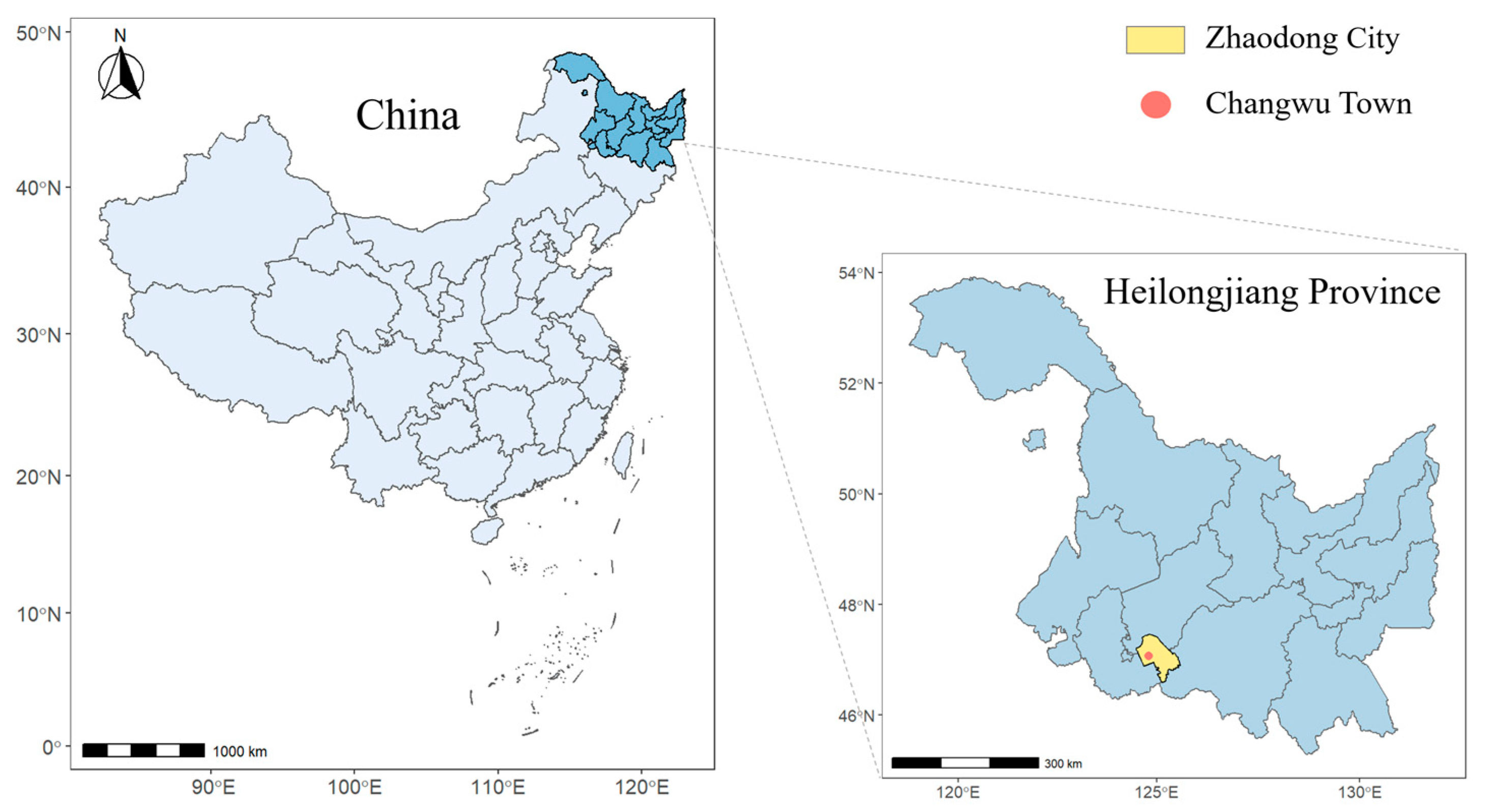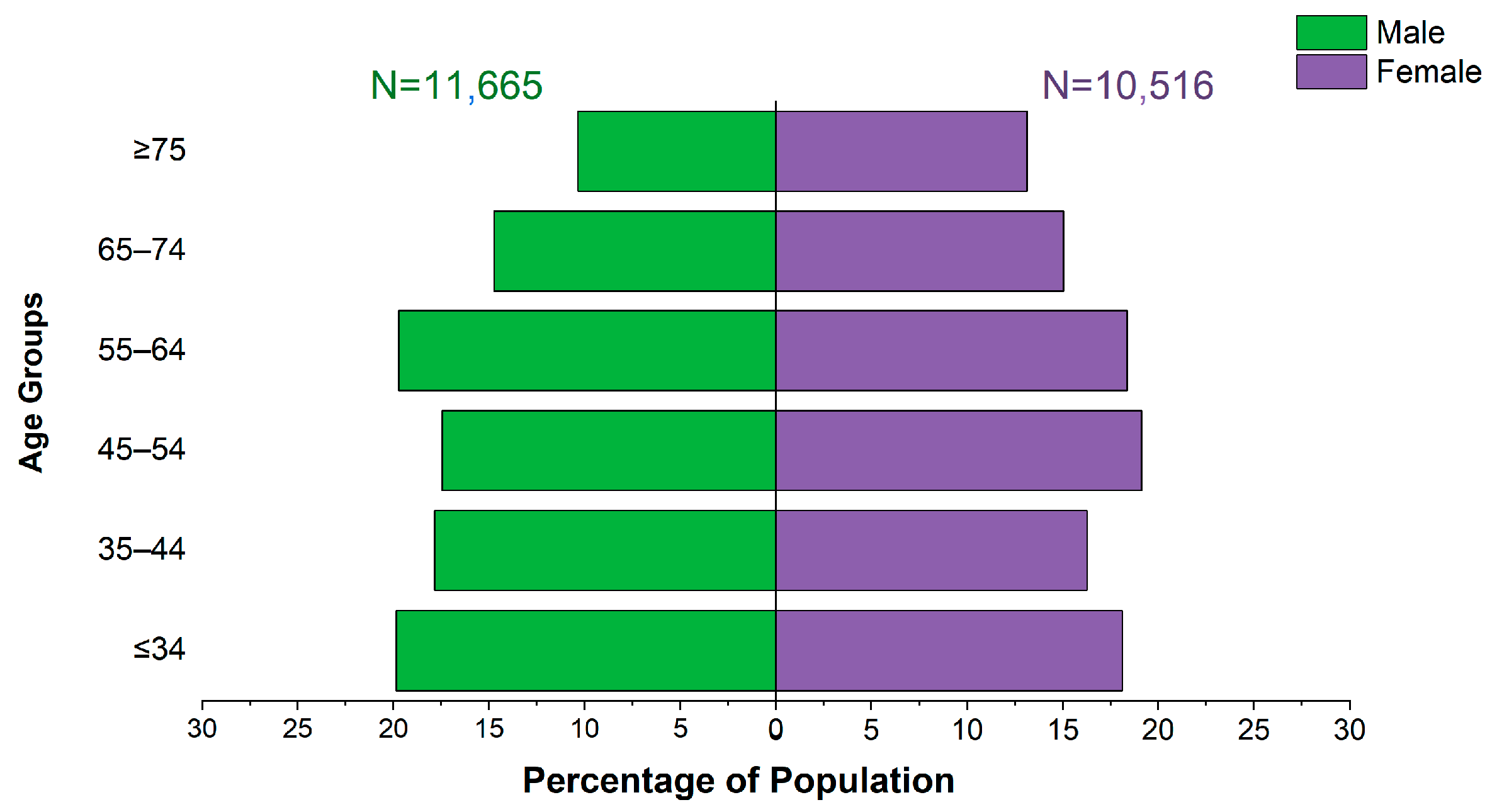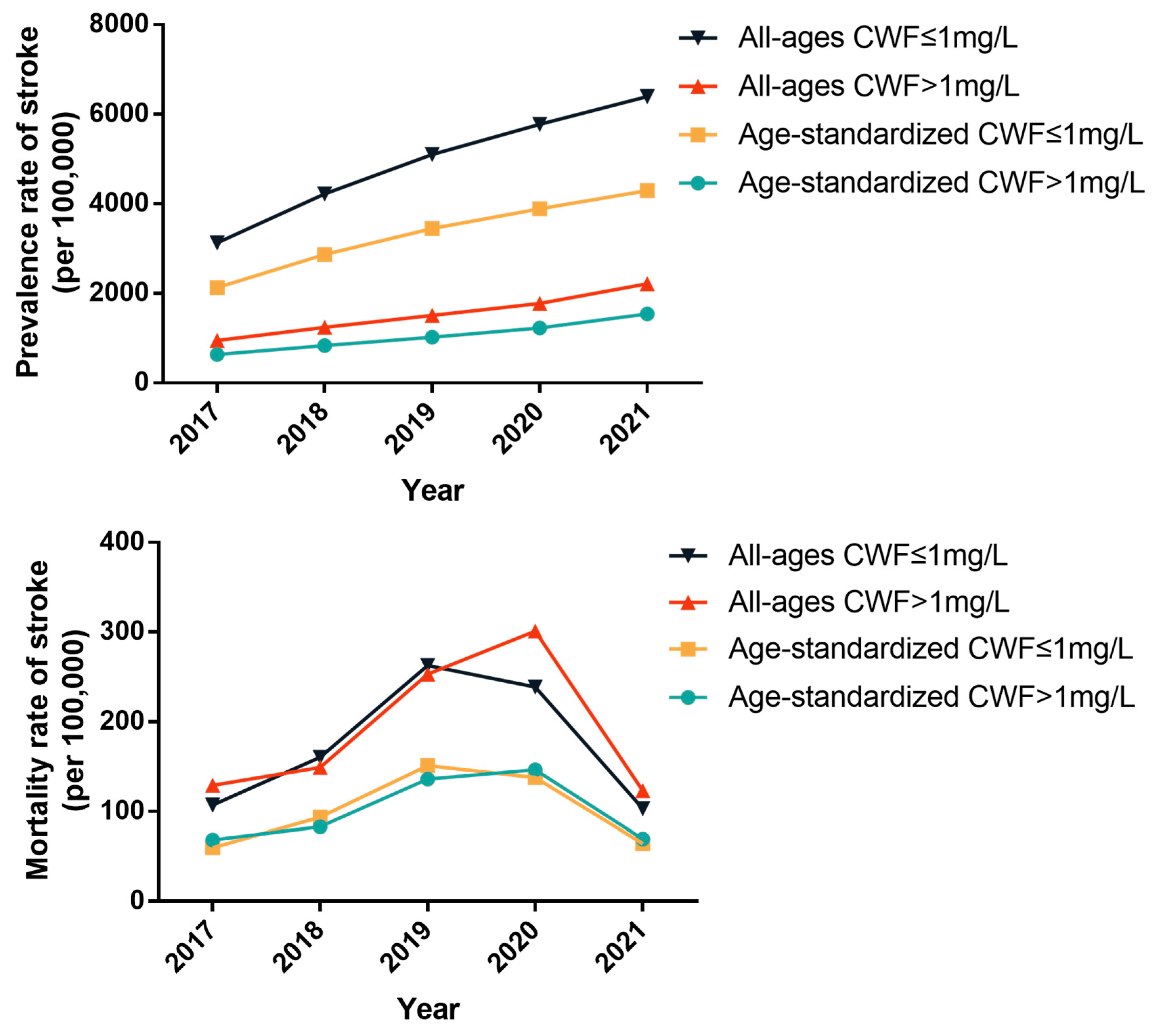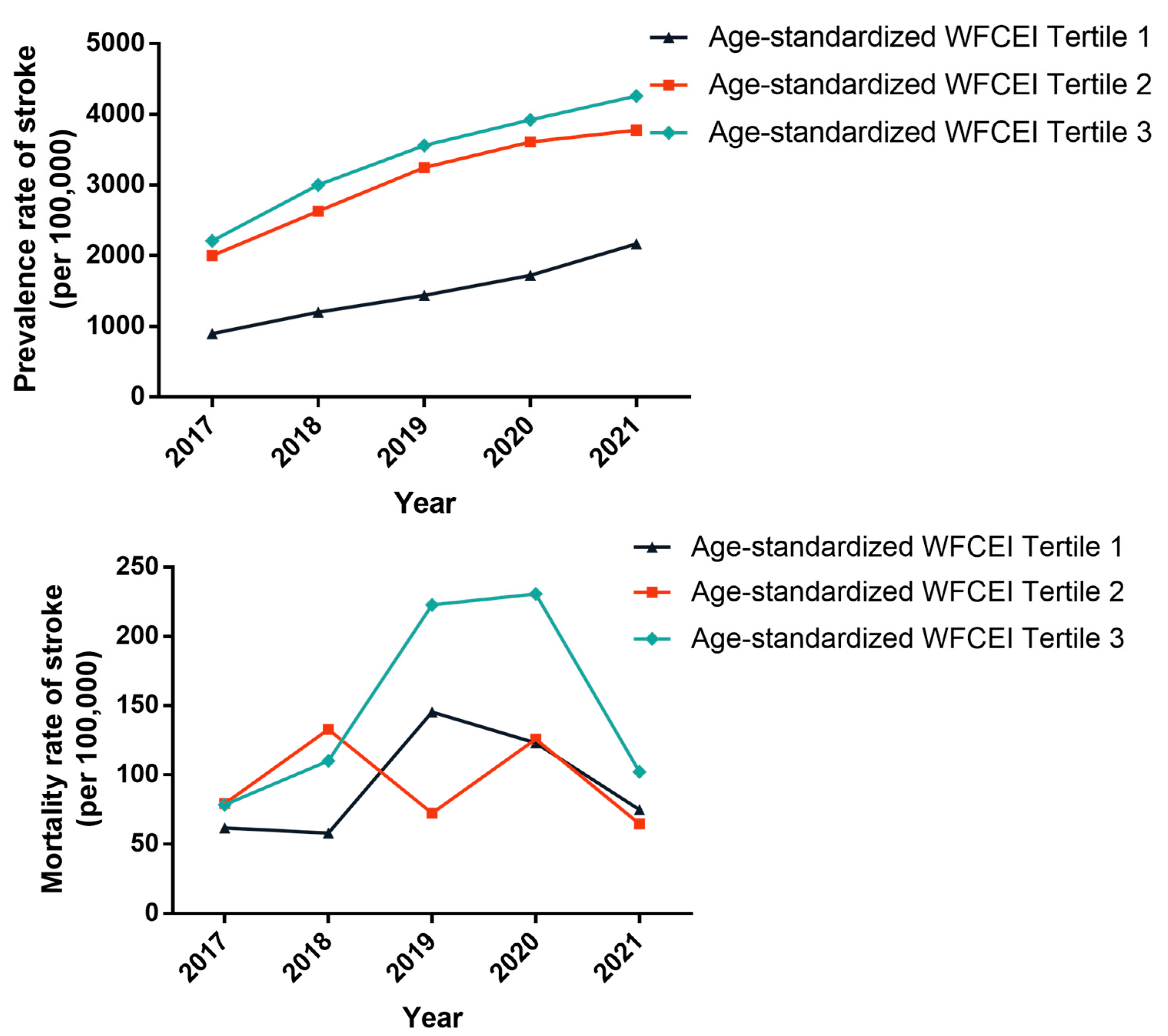Fluoride Exposure from Drinking Water Increases the Risk of Stroke: An Ecological Study in Changwu Town, China
Abstract
1. Introduction
2. Materials and Methods
2.1. Study Location and Population
2.2. Stroke Information Collection
2.3. Data Sources of Historical Water Fluoride Exposure
2.4. Water Sample Collection
2.5. Determination of Fluoride Concentrations in Water Sample
2.6. Water Fluoride Cumulative Exposure Index (WFCEI)
2.7. Statistical Analysis
3. Results
3.1. Population and Fluoride Exposure in Changwu Town
3.2. Descriptive Analysis of the Prevalence and Mortality Rates of Stroke in Changwu Town from 2017 to 2021
3.3. Comparative Analysis of Stroke Prevalence and Mortality Rates across Varying Fluoride Exposure Levels
3.3.1. Comparison of Stroke between Endemic and Non-Endemic Fluorosis Areas
3.3.2. Comparison of Stroke across Different Current Water Fluoride (CWF) Groups
3.3.3. Comparison of Stroke among Different Water Improvement Periods
3.3.4. Comparison of Stroke among Groups with Different Water Fluoride Cumulative Exposure Index (WFCEI)
4. Discussion
5. Conclusions
Supplementary Materials
Author Contributions
Funding
Institutional Review Board Statement
Informed Consent Statement
Data Availability Statement
Acknowledgments
Conflicts of Interest
Abbreviations
| APC | annual percentage change |
| CEDC | Center for Endemic Disease Control |
| CWF | current water fluoride |
| WFCEI | water fluoride cumulative exposure index |
References
- Roth, G.A.; Mensah, G.A.; Johnson, C.O.; Addolorato, G.; Ammirati, E.; Baddour, L.M.; Barengo, N.C.; Beaton, A.Z.; Benjamin, E.J.; Benziger, C.P.; et al. Global Burden of Cardiovascular Diseases and Risk Factors, 1990–2019: Update from the GBD 2019 Study. J. Am. Coll. Cardiol. 2020, 76, 2982–3021. [Google Scholar] [CrossRef] [PubMed]
- Feigin, V.L.; Brainin, M.; Norrving, B.; Martins, S.; Sacco, R.L.; Hacke, W.; Fisher, M.; Pandian, J.; Lindsay, P. World Stroke Organization (WSO): Global Stroke Fact Sheet 2022. Int. J. Stroke 2022, 17, 18–29. [Google Scholar] [CrossRef] [PubMed]
- Pandian, J.D.; Gall, S.L.; Kate, M.P.; Silva, G.S.; Akinyemi, R.O.; Ovbiagele, B.I.; Lavados, P.M.; Gandhi, D.B.C.; Thrift, A.G. Prevention of stroke: A global perspective. Lancet 2018, 392, 1269–1278. [Google Scholar] [CrossRef] [PubMed]
- Ranta, A.; Ozturk, S.; Wasay, M.; Giroud, M.; Béjot, Y.; Reis, J. Environmental factors and stroke: Risk and prevention. J. Neurol. Sci. 2023, 454, 120860. [Google Scholar] [CrossRef] [PubMed]
- Yankoty, L.I.; Gamache, P.; Plante, C.; Goudreau, S.; Blais, C.; Perron, S.; Fournier, M.; Ragettli, M.S.; Hatzopoulou, M.; Liu, Y.; et al. Relationships between long-term residential exposure to total environmental noise and stroke incidence. Noise Health 2022, 24, 33–39. [Google Scholar] [CrossRef]
- Huang, K.; Liang, F.; Yang, X.; Liu, F.; Li, J.; Xiao, Q.; Chen, J.; Liu, X.; Cao, J.; Shen, C.; et al. Long term exposure to ambient fine particulate matter and incidence of stroke: Prospective cohort study from the China-PAR project. BMJ 2019, 367, l6720. [Google Scholar] [CrossRef]
- Singh, G.; Kumari, B.; Sinam, G.; Kriti Kumar, N.; Mallick, S. Fluoride distribution and contamination in the water, soil and plants continuum and its remedial technologies, an Indian perspective—A review. Environ. Pollut. 2018, 239, 95–108. [Google Scholar] [CrossRef]
- Dhar, V.; Bhatnagar, M. Physiology and toxicity of fluoride. Indian J. Dent. Res. 2009, 20, 350–355. [Google Scholar] [CrossRef]
- Davoudi, M.; Barjasteh-Askari, F.; Sarmadi, M.; Ghorbani, M.; Yaseri, M.; Bazrafshan, E.; Mahvi, A.H.; Moohebati, M. Relationship of fluoride in drinking water with blood pressure and essential hypertension prevalence: A systematic review and meta-analysis. Int. Arch. Occup. Environ. Health 2021, 94, 1137–1146. [Google Scholar] [CrossRef]
- Ottappilakkil, H.; Babu, S.; Balasubramanian, S.; Manoharan, S.; Perumal, E. Fluoride Induced Neurobehavioral Impairments in Experimental Animals: A Brief Review. Biol. Trace Elem. Res. 2023, 201, 1214–1236. [Google Scholar] [CrossRef]
- Zhang, C.; Wang, Y.; Huang, F.; Zhang, Y.; Liu, Y.; Wang, Q.; Zhang, X.; Li, B.; Angwa, L.; Jiang, Y.; et al. Fluoride induced metabolic disorder of endothelial cells. Toxicology 2023, 492, 153530. [Google Scholar] [CrossRef] [PubMed]
- Du, C.; Xiao, P.; Gao, S.; Chen, S.; Chen, B.; Huang, W.; Zhao, C. High Fluoride Ingestion Impairs Bone Fracture Healing by Attenuating M2 Macrophage Differentiation. Front. Bioeng. Biotechnol. 2022, 10, 791433. [Google Scholar] [CrossRef] [PubMed]
- Wu, S.; Wang, Y.; Iqbal, M.; Mehmood, K.; Li, Y.; Tang, Z.; Zhang, H. Challenges of fluoride pollution in environment: Mechanisms and pathological significance of toxicity—A review. Environ. Pollut. 2022, 304, 119241. [Google Scholar] [CrossRef] [PubMed]
- Zhou, J.; Sun, D.; Wei, W. Necessity to Pay Attention to the Effects of Low Fluoride on Human Health: An Overview of Skeletal and Non-skeletal Damages in Epidemiologic Investigations and Laboratory Studies. Biol. Trace Elem. Res. 2023, 201, 1627–1638. [Google Scholar] [CrossRef] [PubMed]
- Nakamoto, T.; Rawls, H.R. Fluoride Exposure in Early Life as the Possible Root Cause of Disease in Later Life. J. Clin. Pediatr. Dent. 2018, 42, 325–330. [Google Scholar] [CrossRef]
- Chachra, D.; Limeback, H.; Willett, T.L.; Grynpas, M.D. The long-term effects of water fluoridation on the human skeleton. J. Dent. Res. 2010, 89, 1219–1223. [Google Scholar] [CrossRef]
- Podgorski, J.; Berg, M. Global analysis and prediction of fluoride in groundwater. Nat. Commun. 2022, 13, 4232. [Google Scholar] [CrossRef]
- Wang, F.; Li, Y.; Tang, D.; Zhao, J.; Yang, X.; Liu, Y.; Peng, F.; Shu, L.; Wang, J.; He, Z.; et al. Effects of water improvement and defluoridation on fluorosis-endemic areas in China: A meta-analysis. Environ. Pollut. 2021, 270, 116227. [Google Scholar] [CrossRef]
- Wang, C.; Gao, Y.; Wang, W.; Zhao, L.; Zhang, W.; Han, H.; Shi, Y.; Yu, G.; Sun, D. A national cross-sectional study on effects of fluoride-safe water supply on the prevalence of fluorosis in China. BMJ Open 2012, 2, e001564. [Google Scholar] [CrossRef]
- Wu, J. Challenges for Safe and Healthy Drinking Water in China. Curr. Environ. Health Rep. 2020, 7, 292–302. [Google Scholar] [CrossRef]
- Yani, S.I.; Seweng, A.; Mallongi, A.; Nur, R.; Abdullah, M.T.; Salmah, U.; Sirajuddin, S.; Basir-Cyio, M.; Mahfudz; Anshary, A. The influence of fluoride in drinking water on the incidence of fluorosis and intelligence of elementary school students in Palu City. Gac. Sanit. 2021, 35 (Suppl. S2), S159–S163. [Google Scholar] [CrossRef] [PubMed]
- Malin, A.J.; Till, C. Exposure to fluoridated water and attention deficit hyperactivity disorder prevalence among children and adolescents in the United States: An ecological association. Environ. Health 2015, 14, 17. [Google Scholar] [CrossRef] [PubMed]
- Dewey, D.; England-Mason, G.; Ntanda, H.; Deane, A.J.; Jain, M.; Barnieh, N.; Giesbrecht, G.F.; Letourneau, N. Fluoride exposure during pregnancy from a community water supply is associated with executive function in preschool children: A prospective ecological cohort study. Sci. Total Environ. 2023, 891, 164322. [Google Scholar] [CrossRef] [PubMed]
- Strazielle, N.; Ghersi-Egea, J.F. Physiology of blood-brain interfaces in relation to brain disposition of small compounds and macromolecules. Mol. Pharm. 2013, 10, 1473–1491. [Google Scholar] [CrossRef] [PubMed]
- Yousefi, M.; Yaseri, M.; Nabizadeh, R.; Hooshmand, E.; Jalilzadeh, M.; Mahvi, A.H.; Mohammadi, A.A. Association of Hypertension, Body Mass Index, and Waist Circumference with Fluoride Intake; Water Drinking in Residents of Fluoride Endemic Areas, Iran. Biol. Trace Elem. Res. 2018, 185, 282–288. [Google Scholar] [CrossRef] [PubMed]
- Liu, H.; Gao, Y.; Sun, L.; Li, M.; Li, B.; Sun, D. Assessment of relationship on excess fluoride intake from drinking water and carotid atherosclerosis development in adults in fluoride endemic areas, China. Int. J. Hyg. Environ. Health 2013, 217, 413–420. [Google Scholar] [CrossRef]
- Pérez-Maldonado, I.N.; De la Trinidad-Chacón, C.G.; Perez-Lopez, A.L.; Perez-Lopez, A.A. Association between urinary fluoride concentrations and the prevalence of metabolic syndrome in adult individuals from the Central Region of Mexico. Int. J. Environ. Health Res. 2023, 34, 2877–2887. [Google Scholar] [CrossRef]
- Itai, K.; Onoda, T.; Nohara, M.; Kuribayashi, T.; Tanno, K.; Ohsawa, M.; Mori, M.; Okayama, A. Slightly Elevated Serum Ionic Fluoride Levels Inhibit Insulin Secretion and Increase Glucose Levels in a General Japanese Population: A Cross-sectional Study. Biol. Trace Elem. Res. 2021, 199, 2819–2825. [Google Scholar] [CrossRef]
- Liu, L.; Wang, M.; Li, Y.; Liu, H.; Hou, C.; Zeng, Q.; Li, P.; Zhao, Q.; Dong, L.; Yu, X.; et al. Low-to-moderate fluoride exposure in relation to overweight and obesity among school-age children in China. Ecotoxicol. Environ. Saf. 2019, 183, 109558. [Google Scholar] [CrossRef]
- Adali, M.K.; Varol, E.; Aksoy, F.; Icli, A.; Ersoy, I.H.; Ozaydin, M.; Erdogan, D.; Dogan, A. Impaired heart rate recovery in patients with endemic fluorosis. Biol. Trace Elem. Res. 2013, 152, 310–315. [Google Scholar] [CrossRef]
- Quadri, J.A.; Sarwar, S.; Pinky Kar, P.; Singh, S.; Mallick, S.R.; Arava, S.; Nag, T.C.; Roy, T.S.; Shariff, A. Fluoride induced tissue hypercalcemia, IL-17 mediated inflammation and apoptosis lead to cardiomyopathy: Ultrastructural and biochemical findings. Toxicology 2018, 406–407, 44–57. [Google Scholar] [CrossRef] [PubMed]
- Ma, Q.; Li, R.; Wang, L.; Yin, P.; Wang, Y.; Yan, C.; Ren, Y.; Qian, Z.; Vaughn, M.G.; McMillin, S.E.; et al. Temporal trend and attributable risk factors of stroke burden in China, 1990-2019: An analysis for the Global Burden of Disease Study 2019. Lancet Public Health 2021, 6, e897–e906. [Google Scholar] [CrossRef] [PubMed]
- Wang, W.; Jiang, B.; Sun, H.; Ru, X.; Sun, D.; Wang, L.; Wang, L.; Jiang, Y.; Li, Y.; Wang, Y.; et al. Prevalence, Incidence, and Mortality of Stroke in China: Results from a Nationwide Population-Based Survey of 480 687 Adults. Circulation 2017, 135, 759–771. [Google Scholar] [CrossRef] [PubMed]
- Report on Stroke Prevention and Treatment in China Writing Group. Brief report on stroke prevention and treatment in China (2021). Chin. J. Cerebrovasc. Dis. 2023, 20, 783–793. (In Chinese) [Google Scholar] [CrossRef]
- Melnick, G.; O’Leary, J.F.; Zaniello, B.A.; Abrishamian, L. COVID-19 driven decline in emergency visits: Has it continued, is it permanent, and what does it mean for emergency physicians? Am. J. Emerg. Med. 2022, 61, 64–67. [Google Scholar] [CrossRef]
- Zhang, F.L.; Guo, Z.N.; Wu, Y.H.; Liu, H.Y.; Luo, Y.; Sun, M.S.; Xing, Y.Q.; Yang, Y. Prevalence of stroke and associated risk factors: A population based cross sectional study from northeast China. BMJ Open 2017, 7, e015758. [Google Scholar] [CrossRef]
- Chen, C.; Li, J.; Huang, J. Spatial-Temporal Patterns of Population Aging in Rural China. Int. J. Environ. Res. Public Health 2022, 19, 5631. [Google Scholar] [CrossRef]
- Putaala, J. Ischemic Stroke in Young Adults. Continuum 2020, 26, 386–414. [Google Scholar] [CrossRef]
- Vrudhula, A.; Zhao, J.; Liu, R. Too Young to Have a Stroke?—A Global Health Crisis. Stroke Vasc. Neurol. 2019, 4, 173–175. [Google Scholar] [CrossRef]
- Report on Stroke Prevention and Treatment in China Writing Group. Brief report on stroke prevention and treatment in China (2020). Chin. J. Cerebrovasc. Dis. 2022, 19, 136–144. (In Chinese) [Google Scholar] [CrossRef]
- Zhang, J.; Dili, X.; Ji, F.; Liu, K. An Investigation on the Pulmonary Function of Skeletal Fluorosis Patients in Water -improving Fluorosis Region. Chin. J. Ctrl. Enden. Dis. 2008, 23, 125–127. (In Chinese) [Google Scholar] [CrossRef]
- Veneri, F.; Vinceti, S.R.; Filippini, T. Fluoride and caries prevention: A scoping review of public health policies. Ann. Ig. 2024, 36, 270–280. [Google Scholar] [CrossRef] [PubMed]
- Mohd Nor, N.A.; Chadwick, B.L.; Farnell, D.J.J.; Chestnutt, I.G. Factors associated with dental fluorosis among Malaysian children exposed to different fluoride concentrations in the public water supply. J. Public Health Dent. 2021, 81, 270–279. [Google Scholar] [CrossRef] [PubMed]






| Author (Year) | Study Design | Country | Fluoride Exposure from Drinking Water (mg/L) | Health Effect | Reference | |||
|---|---|---|---|---|---|---|---|---|
| Variables | Range | Mean ± Standard Deviation | Median (Interquartile Range) | |||||
| Our study | Ecological study | China | CWF | 0.14–1.25 | 0.76 ± 0.31 | 0.87 (0.49, 1.02) | Stroke | |
| Historical water fluoride | 0.14–4.50 | 1.51 ± 0.88 | 1.20 (1.02, 2.00) | |||||
| Yani, et al. (2021) | Cross-sectional study | Indonesia | CWF | 0.30 and 1.60 | Intelligence quotient (IQ) | [21] | ||
| Malin, et al. (2015) | Ecological study | the United States | CWF | 0.70–1.20 | Attention-deficit hyperactivity disorder (ADHD) | [22] | ||
| Dewey, et al. (2023) | Ecological cohort study | Canada | CWF | 0–0.70 | Poorer inhibitory control and cognitive flexibility | [23] | ||
| Yousefi, et al. (2018) | Cross-sectional study | Iran | CWF | 0.68–10.30 | Hypertension | [25] | ||
| Liu, et al. (2013) | Cross-sectional study | China | CWF | 0.03–7.83 | 1.95 ± 1.13 | Carotid atherosclerosis | [26] | |
| Itai, et al. (2021) | Cross-sectional Study | Japan | CWF | 0.02–0.15 | Reduce insulin secretion and increase fasting plasma glucose levels | [28] | ||
| Liu, et al. (2019) | Cross-sectional study | China | CWF | 0.20–3.50 | 1.00 (0.40, 1.53) | Overweight and obesity | [29] | |
| Adali, et al. (2013) | Prospective study | Turkey | CWF | 0.53 ± 0.06 and 2.74 ± 064 | Impaired heart rate recovery | [30] | ||
| Year | Number | Prevalence Rate | Mortality Rate | |||
|---|---|---|---|---|---|---|
| Patients | Deaths | All-Ages | Age-Standardized | All-Ages | Age-Standardized | |
| 2017 | 483 | 27 | 2101.6 | 1450.8 | 117.5 | 64.1 |
| 2018 | 633 | 35 | 2804.7 | 1935.9 | 155.1 | 87.4 |
| 2019 | 763 | 58 | 3398.3 | 2337.4 | 258.3 | 143.7 |
| 2020 | 866 | 60 | 3876.1 | 2667.3 | 268.6 | 142.5 |
| 2021 | 978 | 25 | 4409.3 | 3024.5 | 112.7 | 65.9 |
| APC | 18.9 ** | 18.7 ** | 9.5 | 7.6 | ||
| APC 95%CI | 12.1~26.2 | 11.9~26.0 | −35.3~85.0 | −34.5~76.7 | ||
| t-value | 9.3 | 9.2 | 0.5 | 0.5 | ||
| p-value † | 0.003 | 0.003 | 0.622 | 0.671 | ||
Disclaimer/Publisher’s Note: The statements, opinions and data contained in all publications are solely those of the individual author(s) and contributor(s) and not of MDPI and/or the editor(s). MDPI and/or the editor(s) disclaim responsibility for any injury to people or property resulting from any ideas, methods, instructions or products referred to in the content. |
© 2024 by the authors. Licensee MDPI, Basel, Switzerland. This article is an open access article distributed under the terms and conditions of the Creative Commons Attribution (CC BY) license (https://creativecommons.org/licenses/by/4.0/).
Share and Cite
Yuan, L.; Sun, H.; Li, Y.; Xing, Z.; Yin, S.; Xie, F.; Zhou, J.; Li, S.; Wu, L.; Huang, W.; et al. Fluoride Exposure from Drinking Water Increases the Risk of Stroke: An Ecological Study in Changwu Town, China. Toxics 2024, 12, 679. https://doi.org/10.3390/toxics12090679
Yuan L, Sun H, Li Y, Xing Z, Yin S, Xie F, Zhou J, Li S, Wu L, Huang W, et al. Fluoride Exposure from Drinking Water Increases the Risk of Stroke: An Ecological Study in Changwu Town, China. Toxics. 2024; 12(9):679. https://doi.org/10.3390/toxics12090679
Chicago/Turabian StyleYuan, Lin, Hongna Sun, Yue Li, Zhifeng Xing, Shihui Yin, Fengyu Xie, Jing Zhou, Shuang Li, Liaowei Wu, Wei Huang, and et al. 2024. "Fluoride Exposure from Drinking Water Increases the Risk of Stroke: An Ecological Study in Changwu Town, China" Toxics 12, no. 9: 679. https://doi.org/10.3390/toxics12090679
APA StyleYuan, L., Sun, H., Li, Y., Xing, Z., Yin, S., Xie, F., Zhou, J., Li, S., Wu, L., Huang, W., Wang, T., Gao, Y., Zhao, L., & Sun, D. (2024). Fluoride Exposure from Drinking Water Increases the Risk of Stroke: An Ecological Study in Changwu Town, China. Toxics, 12(9), 679. https://doi.org/10.3390/toxics12090679




